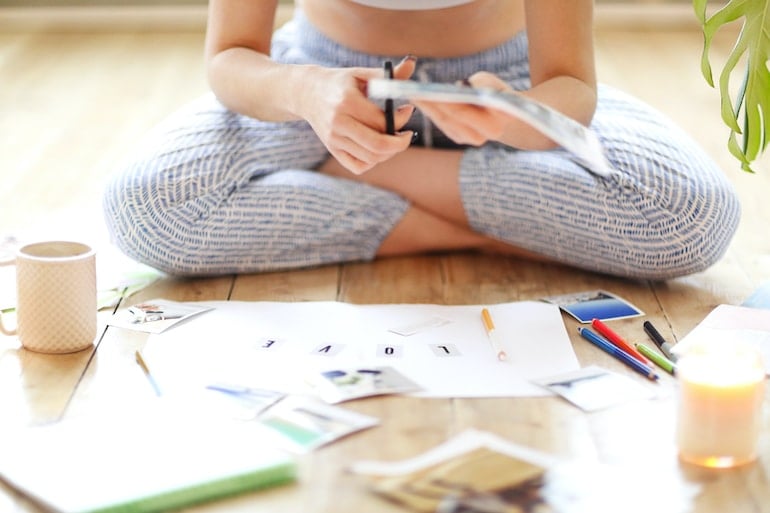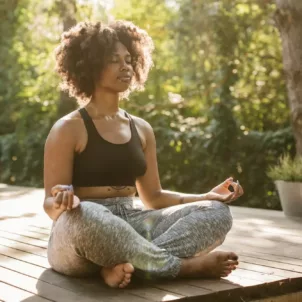Medically Reviewed By
Gaby Vaca-Flores, RDN, CLE
Registered Dietitian Nutritionist
Here’s your guide to the power of visualization, including benefits, expert tips, and the mechanisms at work behind it.
Some people are born with the notion that they’ll achieve greatness. Meanwhile, others need to put more work into viewing their future in a positive light. Daily visualization—or creating a mental vision board—can help solidify and reinforce a positive outlook to help you feel empowered and manifest your goals.


Benefits of Visualization
For many, visualization can feel cheesy, forced, or inauthentic—but it doesn’t have to. Also, the benefits of visualization are well worth any initial hesitation. In fact, many studies show that positive visualization work can help decrease both physical and emotional stress levels, as well as allow us to function more optimally. It can even be an effective tool for pain management. Next, visualization in the form of positive-outcome predicting can have a huge impact on how we shape the course of our lives. A 2016 study shows that this type of thinking drastically reduces unproductive worry-mentality and decreases stress.
A Life Coach on How to Get Started
Visualization doesn’t need to feel much different than daydreaming. Rather than engaging in negative self-talk, start replacing doubt with thoughts of “what if.” Otherwise, you can simply imagine your ideal scenario. It’s so broad, that it could be anything, and it doesn’t have to be an image of an entire perfect life laid out before you. For instance, every night before bed, think about your realistic dream home, kitchen, garden, or family tradition. It could also be a trip, an outfit, or even a declaration of love. Jacki Carr, a renowned goal coach and motivational speaker, is a huge proponent of visualization as an instrument to help people find their driving force. If images of bliss and success don’t arise easily, Jacki suggests more tangible visualization tips to help get started.Create a Vision Board
“I’m first and foremost a vision boarder. I truly love carving out space to sit and dream with magazines and glue,” she starts. “Often I’ll need an activity to create a pause or disruption in my day to make the space to design my future. I truly believe that glue equals commitment.” Of course, you can also practice visualization without props, but it can certainly help to get your hands dirty.Move Your Body + Reflect
Another pro tip to harness the power of visualization: get in the right headspace with movement. After, Jacki also recommends guided meditation, perhaps after a dance or yoga class, to explore the edges of your mind and see yourself 10 years in the future. Here, Jacki suggests reflecting, with questions such as:- Who are you with?
- Where are you?
- What are you doing with your time?
- What inspires you in this space?

How Your Brain Registers Visualization
However, know that this self-empowerment practice isn’t just glitter and glue and collages and dancing. There’s some hard-wired science behind the power of visualization. As Jacki explains, “Our brain actually sees in imagery and pictures, not letters or groups of words. Gifting ourselves images of the future via a vision board (mental or physical) or guided meditation is a way to allow the right brain to dream, be creative, and steep itself in possibility. Our left brain can then take the imagery and analyze how to place it into logical steps and goals.” It’s a beautiful thing to integrate and explore both sides of the brain and step into our whole-brained leadership style. But it’s not just a pretty concept. Meteor Education, a resource for educators helping to shape the way children learn and adapt, studies how positive thoughts can expand neuroplasticity. This phenomenon illustrates that positive thinking can actually help us be smarter and more adept, in a way, by accessing greater cognitive function. Thoughts create chemical reactions in the brain, after all, and nearly every part of our body is governed by chemical reactions.The Bottom Line
While incredibly powerful, visualization isn’t a magical manifestation technique, but rather an energy shift that will yield tangible results over time. “It’s powerful to know and honor the details or the rudimentary routines of our day-to-day lives. Our habits and how we choose to live each moment is our legacy in action now. However, the ability to dream, to ask ourselves what we want in the years to come, allows us a freedom from constraints—like time, money, and education—you might be feeling in the present moment,” Jacki clarifies. “A visualization practice allows us to stop ‘shoulding’ ourselves. It permits us to check in on our truth and what matters most as we start to see our dreams in experiences, in inspiration, in what stays the same and what we want to change,” she continues. Jacki details that the most positive effect of this practice is to then choose to align your daily actions, thoughts, and words in light of the future you want. It should embody what you’ve written in your notebook, pasted to your vision board, or imagined each day. In sum, you hold the power to design the future you want. Picture that.More like this









